Your Call?
Which of the images featured in this blog post is your favorite?
What’s Up?
Congrats to the beyond amazing Caitlin Clark of Iowa and to Paige Bueckers of UConn for leading their teams to the Women’s Final Four in the Ladies “March Madness” NCAA college basketball tournament.
When I went down to the lake on Wednesday morning, the parents of the first pair of Sandhill Crane chicks that hatched at ILE about two weeks ago were foraging alone. Thus, I am 99.99% sure that the both of chicks perished some time on in the last two days. The two chicks that hatched more recently were doing fine yesterday.
Today is 4 April 2024. I will be heading down to the lake early today for a short visit. I have lots to do today and look forward to getting stuff done. Whatever you are doing I hope that you too opt to have a great day.
Don’t look now but this blog post makes five days in a row with a new educational post just for you.
If you plan on purchasing a Sony a9 III Mirrorless Camera (or anything else for that matter), please remember to use or write for either my Bedfords discount code or my B&H affiliate link. Folks who use one of my two affiliate links to purchase the a9 III will receive my .DAT settings (the complete camera set-up) along with a Buttons and Dials Guide.
Please remember to use the B&H links that are found on most blog pages and to use the BIRDSASART discount code at checkout when purchasing your new gear from Bedfords to get 3% back on your credit card and enjoy free second-day air FedEx. Please, also, consider joining a BAA IPT. You will be amazed at how much you will learn!
If an item — a Delkin flash card, or a tripod head — for example, that is available from B&H and/or Bedfords, is also available in the BAA Online Store, it would be great, and greatly appreciated, if you would opt to purchase from us. We will match any price. Please remember also to use my B&H affiliate links or to earn 3% cash back at Bedfords by using the BIRDSASART discount code at checkout for your major gear purchases. Doing either often earns you free guides and/or discounts. And always earns my great appreciation.
|
|
|
For those who did not use my link to purchase their Sony 300mm f/2.8 GM lens, this item should be in the store this afternoon (for real this time). Click on the image to enlarge and to be able to read the fine print. |
The BAA Sony 300mm f/2.8 Lens Guide
Impressed by my Sony FE 300mm f/2.8 GM OSS Lens (Sony E) images from the last three posts? Use either my Bedfords or B&H affiliate link to purchase your Sony 300mm f/2.8 GM lens and shoot me your receipt via e-mail and request a copy of the first-ever BAA Lens Guide. This short guide will be published this afternoon. I thought that it would take only minutes to create this guide, but I was dead wrong. In the process of creating it, I learned a ton about the lens. And even better, I discovered a simple yet potentially fatal flaw that was resulting in sporadically unsharp flight images. The set-up fix is simple. Just be sure to use one of my affiliate links and get the guide for free.
|
|
|
This image was also created on 26 March 2024 at Circle B Bar Reserve in Lakeland, FL. Standing at full height, I used the Robus RC-5558 Vantage Series 3 Carbon Fiber Tripod/Levered-Clamp FlexShooter Pro-mounted Sony FE 600mm f/4 GM OSS lens and The One, the Sony Alpha 1 Mirrorless digital camera. ISO 3200. Exposure was determined via Zebras with ISO on the rear dial: 1/250 sec. at f/4 (wide open). AWB at 7:44:42am on a partly sunny morning. Tracking: Expand Spot AF-C with Bird Face/Eye detection enabled was active at the moment of exposure and performed perfectly. Be sure to click on the image to enjoy the larger version. Image #1: Red-shouldered Hawk gently sidelit by the rising sun in moss-draped tree setting |
More Moss!
In the Same Bird. Same Lens. Two Slightly Different Images blog post here, the small in the frame version (Image #1, above) was best by far according to me and all those who commented. Yes, one of the reasons I placed the bird on the right side looking out of the frame was to use the branch as a leading line, but more importantly for me, was to include more of the hanging moss in the frame; there was none to my right.
Image #2 was sharp and well-composed, and the rear view was nice, but this one was nothing really special.
|
|
|
This image was created on 30 March 2024 down by the lake near my home in Indian Lake Estates, FL. Seated on damp grass, I used the toepod technique with the handheld Sony FE 300mm f/2.8 GM OSS Lens (Sony E) and the ridiculously amazing Sony a9 III Mirrorless Camera. The exposure was determined via Zebra technology with ISO on the Thumb Dial. ISO 1000: 1/1000 sec. at f/2.8 (wide open) in Manual mode. When evaluated in RawDigger, the raw file brightness was determined to be dead solid perfect. AWB at 7:33:24am on a clear sunny morning about 15 minutes after sunrise. Tracking Zone/AF-C with Bird Face/Eye detection enabled performed to perfection. Be sure to click on the image to enjoy the high-res version. Image #1: Sandhill Crane chick in purple flowers |
Nothing Bugged Me! (Or Not?)
In the One in the Sun for Good Measure & a 2nd Nest Hatches blog post here, absolutely nothing bugged me. I just asked if anything bugged you 🙂
Here’s what I loved about this image:
1- The choice of perspective.
2- The layers of luscious colors (the result of 1 above).
3- The clean golden chick and the down-the-lens-barrel look.
4- The out of focus layer of shaded grass and flowers at the bottom of the frame.
5- The row of sharp sunlit purple flowers on the same plane as the chick.
6- The row of shaded purple flowers to the right of the chick. They were shaded by the adult that stood to the right of the chick. That they were darker than the sunlit purple flowers to our left of the chick added depth.
7- The out-of-focus strip of green grass between the flowers and the marsh.
8- The golden sunlit marsh grasses.
9- The out-of-focus blue of Lake Walk-in-water.
Or Not?
Though I obviously love this image, the merge of the crane chick’s head with the top edge of the marsh grasses does bother me a tiny bit. I wonder if I should have squeezed my feet together to raise the lens perhaps two inches. That would have eliminated the merge but might have destroyed the arrangement of the many different layers of colors and tones …
|
|
|
This image was also created on 28 March 2024 down by the lake near my home in Indian Lake Estates, FL. Seated on damp grass, I used the knee-pod technique with the handheld Sony FE 300mm f/2.8 GM OSS Lens (Sony E) with the Sony FE 1.4x Teleconverter and the ridiculously amazing Sony a9 III Mirrorless Camera. The exposure was determined via Zebra technology with ISO on the Thumb Dial. ISO 500: 1/500 sec. at f/4 (wide open) in Manual mode. When evaluated in RawDigger, the raw file brightness was determined to be perfect. AWB at 8:47:32am as things brightened up just a bit. Tracking: Expand Spot/AF-C with Bird Face/Eye detection enabled performed well. Be sure to click on the image to enjoy a high-res version. Image #3: Sandhill Crane chick eating mole cricket |
In the I Never Gave Up Hope 🙂 Crane Chicks in Purple Flowers blog post here, my favorite image was the one that did not include purple flowers in the frame, Image #3, above. Why? #1, as pointed out by Cliff Beittel, was simply was not sharp on face at 1/500 second. And #3 is the only tight shot of a crane food handoff that features two acceptable head angles. I have hundreds where with the head of the adult or the head of the chick is angled away.
|
|
|
This image was created on 28 March 2024 down by the lake near my home in Indian Lake Estates, FL. Seated on damp grass, I used the toepod technique with the handheld Sony FE 300mm f/2.8 GM OSS Lens (Sony E) and the ridiculously amazing Sony a9 III Mirrorless Camera. The exposure was determined via Zebra technology with ISO on the Thumb Dial. ISO 2000: 1/500 sec. at f/2.8 (wide open) in Manual mode. When evaluated in RawDigger, the raw file brightness was determined to be perfect. AWB at 8:29:00am on a very overcast morning. Tracking Zone/AF-C with Bird Face/Eye detection enabled performed to perfection. Be sure to click on the image to enjoy the high-res version. Image #1: Sandhill Crane chick running to adult to grab a morsel |
Much Loved
Most folks, including multiple IPT veteran David Pugsley (who was there), went with Image #1 — immediately above — as their favorite because of the cuteness factor, the running action, the raised wings, and the purple flowers. Thanks to a modicum of Topaz Sharpen AI, the image looked OK for web presentation, but know that it was not critically sharp on the face was too much for me to overcome.
That brings us to the why double the ISO? question. Had I raised the ISO to 4000 I could have doubled the shutter speed to 1/1000 sec. and created a sharper image. That is an error that I make over and over again. It is much easier to deal with high ISO noise than it is to deal with motion blur. But old habits (avoiding very high ISOs), are hard to break.
|
|
|
This image was created on 28 March 2024 down by the lake near my home in Indian Lake Estates, FL. Seated on damp grass, I used the toepod technique with the handheld Sony FE 300mm f/2.8 GM OSS Lens (Sony E) and the ridiculously amazing Sony a9 III Mirrorless Camera. The exposure was determined via Zebra technology with ISO on the Thumb Dial. ISO 2000: 1/500 sec. at f/2.8 (wide open) in Manual mode. When evaluated in RawDigger, the raw file brightness was determined to be perfect. AWB at 8:29:00am on a very overcast morning. Tracking Zone/AF-C with Bird Face/Eye detection enabled performed to perfection. Be sure to click on the image to enjoy the high-res version. Image #1A: An improved version of the Sandhill Crane chick running to adult to grab a morsel image |
A Better Version
When John (Storjohann) posted the comment below (in part), I realized that while I had enhanced the catchlight in Images #2 and #3, I failed to do that with Image #1.
I love the animated pose in the first image (along with the color of the spring flowers and the strong composition). I wish there had been a stronger catch light in the predominantly black eye. The second image is also beautiful, if not as animated, and there is a catch light in the the eye that gives direction to the chick’s gaze.
So, I decided to improve the optimized version by enhancing the catchlight and juicing up the colors a bit. To enhance the catchlight I used a new technique that will be detailed in future Digital Basics III recordings. To enrich the purples I used another new technique that I developed only recently. It too will be detailed in future Digital Basics III recordings.
WDYT?
How did I do? To better see the catchlight, be sure to enlarge the two images by clicking on each of them. Can you note the brighter Purples and Greens?
Typos
With all blog posts, feel free to e-mail or to leave a comment regarding any typos or errors.

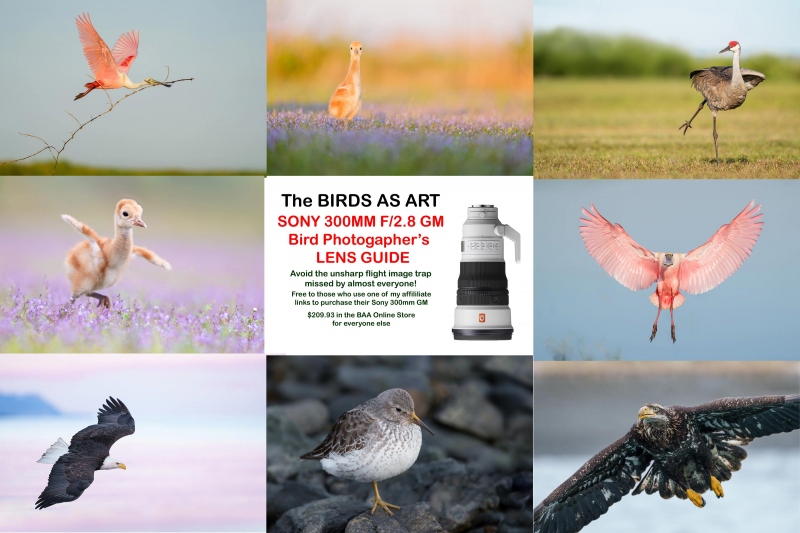
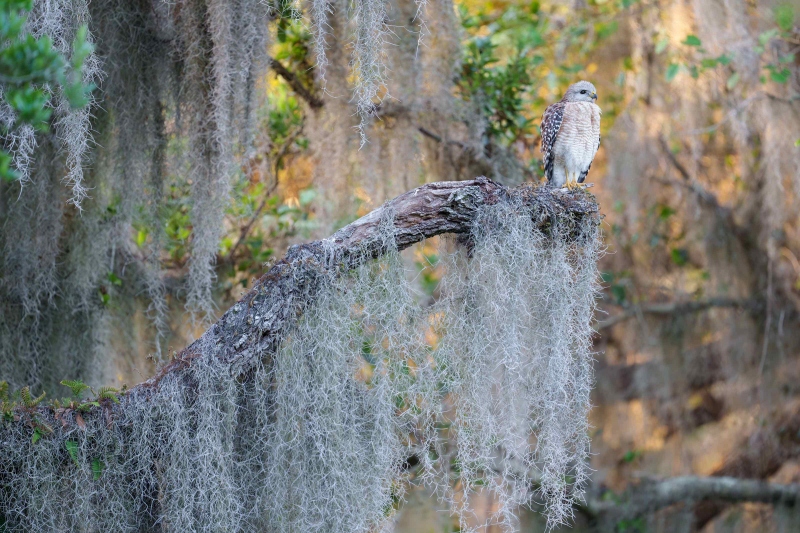
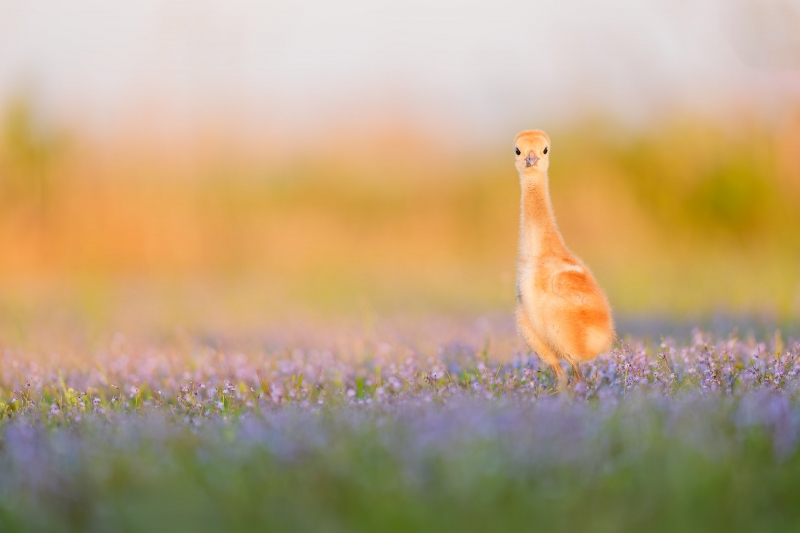
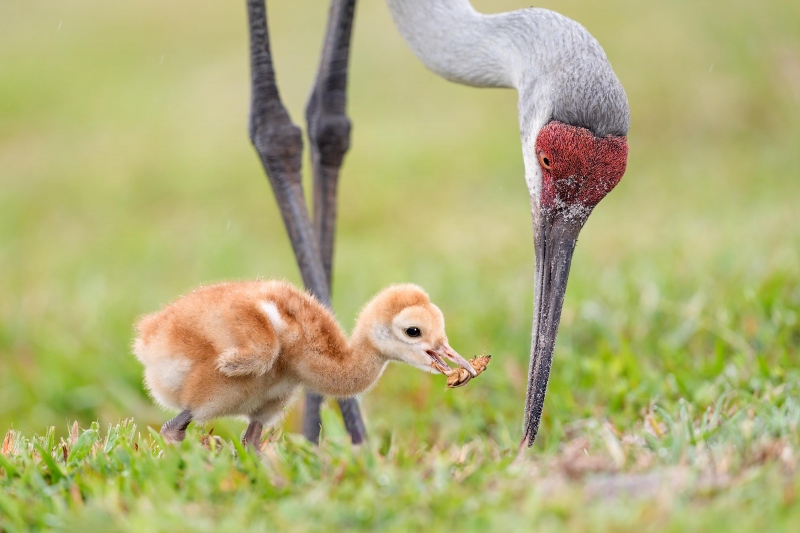
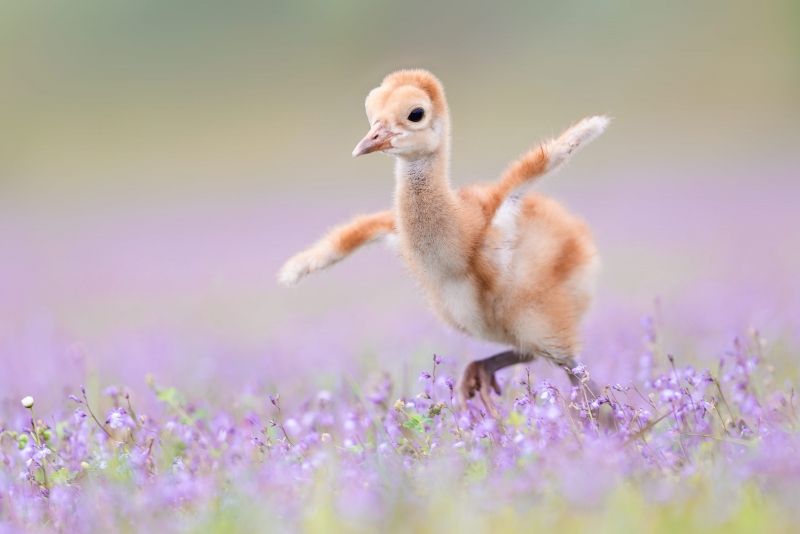
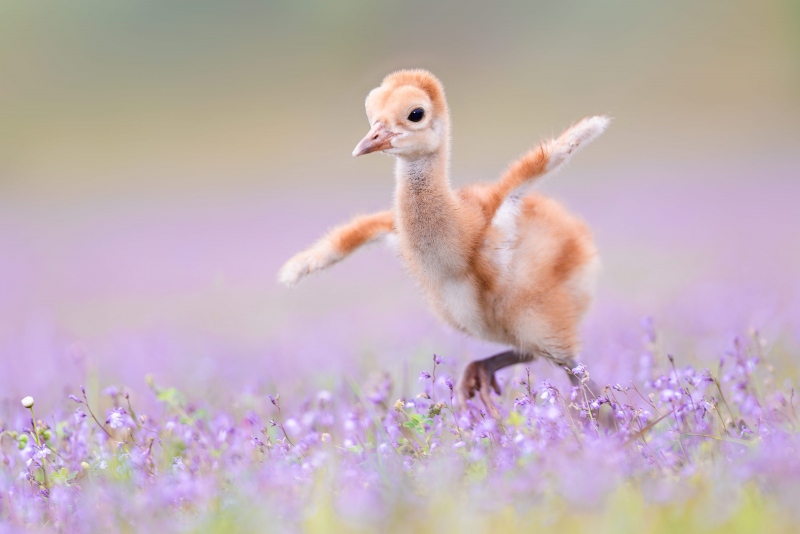













Artie, I really like the stronger catchlight on the image…job well done!…and thank your for revisiting the topic of comments/suggestions/etc. on the series of images. I’ve been in the classroom as a teacher for 45 years…the best learning takes place when all parties are actively engaged in the conversation. This is a perfect example of that, and I appreciate it.
Thanks on all counts, John. Especially for your comments on teaching and learning. One thing is for sure, I am a much better teacher than I am a bird photographer. What continues to mystify me, as we have discussed via e-mail, is how few folks have signed up for IPTs over the last five years of so.
much love, artie
Love the hawk and moss
#1 chick with line of colors above head doesn’t bother me because the line is not through the head.
#3 cranes is great. it has a story
I really like the Red-shouldered Hawk. The bird is placed nicely in the frame and the distant background helps for separation. The moss and overall habitat are a bonus!